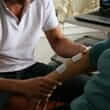Background
- Acustimulation is the mild electrical stimulation of acupuncture points to control symptoms such as nausea and vomiting. A low intensity electrical current is used to penetrate just slightly below the surface of the skin.
- It may be delivered by acupuncture needles attached to electrodes or, more commonly, by battery-powered appliances that can be worn on the body (touching the surface of the skin).
- The Neiguan point (P6) is an acupuncture point on the wrist that has been used in acupuncture (without electricity) for approximately 3,000 years to overcome gastric symptoms such as nausea and vomiting. This is the most common point used in acustimulation.
References
- Bertolucci LE, DiDario B. Efficacy of a portable acustimulation device in controlling seasickness. Aviat Space Environ Med 1995;66(12):1155-1158.
View Abstract - Kabalak AA, Akcay M, Akcay F, et al. Transcutaneous electrical acupoint stimulation versus ondansetron in the prevention of postoperative vomiting following pediatric tonsillectomy. J Altern Complement Med 2005;11(3):407-413.
View Abstract - Kramer BA, Kadar AG, Clark K. Transcutaneous acupoint electrical stimulation in preventing and treating nausea and vomiting in patients receiving electroconvulsive therapy. J ECT 2003;19(4):194-196.
View Abstract - Lee A, Done ML. Stimulation of the wrist acupuncture point P6 for preventing postoperative nausea and vomiting. Cochrane Database Syst Rev 2004;(3):CD003281.
View Abstract - Roscoe JA, Matteson SE, Morrow GR, et al. Acustimulation wrist bands are not effective for the control of chemotherapy-induced nausea in women with breast cancer. J Pain Symptom Manage 2005;29(4):376-384.
View Abstract - Roscoe JA, Morrow GR, Hickok JT, et al. The efficacy of acupressure and acustimulation wrist bands for the relief of chemotherapy-induced nausea and vomiting. A University of Rochester Cancer Center Community Clinical Oncology Program multicenter study. J Pain Symptom Manage 2003;26(2):731-742.
View Abstract - Roscoe JA, Jean-Pierre P, Morrow GR, et al. Exploratory analysis of the usefulness of acupressure bands when severe chemotherapy-related nausea is expected. J Soc Integr Oncol 2006 Winter;4(1):16-20.
View Abstract - Shiao SY, Dibble SL. Metaanalyses of acustimulation effects on nausea and vomiting across different patient populations: a brief overview of existing evidence. Explore (NY) 2006 May;2(3):200-1.
View Abstract - Slotnick RN. Safe, successful nausea suppression in early pregnancy with P-6 acustimulation. J Reprod Med 2001;46(9):811-814.
View Abstract - Tarcin O, Gurbuz AK, Pocan S, et al. Acustimulation of the neiguan point during gastroscopy: Its effects on nausea and retching. The Turkish Journal of Gastroenterology 2004;15(4):258-262.
- Treish I, Shord S, Valgus J, et al. Randomized double-blind study of the Reliefband as an adjunct to standard antiemetics in patients receiving moderately-high to highly emetogenic chemotherapy. Support Care Cancer 2003;11(8):516-521.
View Abstract - White PF, Hamza MA, Recart A, et al. Optimal timing of acustimulation for antiemetic prophylaxis as an adjunct to ondansetron in patients undergoing plastic surgery. Anesth Analg 2005;100(2):367-372.
View Abstract - White PF, Issioui T, Hu J, et al. Comparative efficacy of acustimulation (ReliefBand) versus ondansetron (Zofran) in combination with droperidol for preventing nausea and vomiting. Anesthesiology 2002;97(5):1075-1081.
View Abstract - Williams T, Mueller K, Cornwall MW. Effect of acupuncture-point stimulation on diastolic blood pressure in hypertensive subjects: a preliminary study. Phys Ther 1991;71(7):523-529.
View Abstract - Zarate E, Mingus M, White PF, et al. The use of transcutaneous acupoint electrical stimulation for preventing nausea and vomiting after laparoscopic surgery. Anesth Analg 2001;92(3):629-635.
View Abstract







